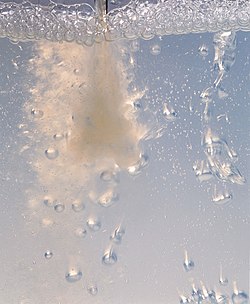Understanding How a Chemical Defoamer Works to Boost Industrial Processes
Chemical defoamers play an essential duty in optimizing industrial processes by effectively mitigating foam-related obstacles. What continues to be to be checked out is exactly how these defoamers can be tailored to meet details functional demands.
What Is a Chemical Defoamer?
A chemical defoamer is a substance specifically created to lower or get rid of the formation of foam in various commercial procedures. Lathering can hinder manufacturing effectiveness, affecting the top quality and efficiency of products in fields such as food and drink, pharmaceuticals, and wastewater therapy. Defoamers are vital in these applications, as extreme foam can lead to functional challenges, such as overflow, reduced blending efficiency, and prevented warm transfer.
The choice of an ideal defoamer is important, as various formulations may be customized for specific processes or kinds of foam. Factors such as compatibility with other active ingredients, temperature stability, and the designated application play a substantial role in the efficiency of a defoamer.
Devices of Defoaming Action
The mechanisms of defoaming action include complicated interactions in between the defoamer and the foam framework. When a defoamer is presented to a foaming system, it migrates quickly to the surface area of the foam bubbles, displacing the supporting representatives that add to foam security.
As smaller bubbles merge into bigger ones, the total security of the foam lessens. Additionally, certain defoamers may contain hydrophobic components that enhance their ability to destabilize the foam by creating a barrier that inhibits bubble formation. This twin activity-- surface area stress decrease and destabilization-- enables for a much more effective malfunction of foam.

In addition, the viscosity and spreading characteristics of the defoamer play crucial roles in its performance. A well-formulated defoamer will certainly make sure rapid migration and optimum efficiency, reducing foam formation throughout commercial processes. By understanding these devices, sectors can better select and use chemical defoamers to enhance operational performance and item quality.
Kinds Of Chemical Defoamers
Chemical defoamers can be classified into numerous kinds, each customized to details applications and foam obstacles. The key categories consist of silicone-based, non-silicone-based, and powder defoamers.
Silicone-based defoamers are very reliable as a result of their capacity to spread out swiftly across liquid surface areas. They provide superb foam suppression and stability, making them appropriate for various commercial applications, including adhesives and finishes. Non-silicone-based defoamers, on the other hand, usually depend on natural compounds like fats or esters. These are especially preferred in food and beverage sectors because of their reduced toxicity and governing compliance.
Powder defoamers include solid bits that can be included in dry procedures or solutions. They are typically made use of in processes where liquid defoamers might not work, supplying an unique service for details applications, such as in the production of specific kinds of plastics or powders.
Furthermore, each kind of defoamer can be tailored resource with various additives to boost efficiency, such as surfactants or emulsifiers, enabling versatility in attending to various frothing scenarios across several sectors.
Applications in Industrial Processes

In the food and beverage market, defoamers are crucial throughout the production of juices, beers, and milk items, where excessive foam can prevent mixing and purification processes. By lowering foam formation, defoamers help preserve consistent item quality and enhance processing times.
In drugs, the presence of foam throughout the mixing and formula of medicines can impact dose accuracy and item stability. Defoamers make sure smooth operations, therefore assisting in the production of high-grade pharmaceuticals.
Wastewater therapy facilities additionally depend on defoamers to manage lathering in oygenation tanks, which can otherwise decrease therapy performance and make complex sludge handling. By successfully taking care of foam, these chemicals boost the general efficiency of therapy procedures and contribute to governing compliance.

Advantages of Making Use Of Defoamers
While foam can present significant obstacles throughout numerous markets, using defoamers provides numerous advantages that boost functional effectiveness and product honesty. Defoamers properly lower or get rid of foam development, causing smoother production processes and boosted item quality. This decrease in foam decreases interruptions during production, enabling continuous procedure and boosted throughput.
Furthermore, the application of more tips here defoamers can lead to set you back savings by decreasing the demand for excess basic materials and energy consumption connected with foam management. By enhancing the production procedure, producers can achieve greater yields and reduced waste, ultimately boosting success.
In addition, defoamers add to better devices performance. Foam accumulation can lead to obstructing, overflow, and equipment wear, causing costly downtime and upkeep. By preventing these concerns, defoamers extend the life expectancy of machinery and minimize operational prices.
Conclusion

A chemical defoamer is a material specifically created to remove view publisher site the formation or reduce of foam in numerous industrial procedures. When a defoamer is introduced to a frothing system, it migrates swiftly to the surface of the foam bubbles, displacing the maintaining agents that add to foam stability. A well-formulated defoamer will certainly make sure rapid movement and optimum performance, decreasing foam formation during industrial procedures. Defoamers effectively lower or eliminate foam development, leading to smoother production procedures and boosted product top quality.In conclusion, chemical defoamers play an essential role in improving commercial processes by properly decreasing foam development.